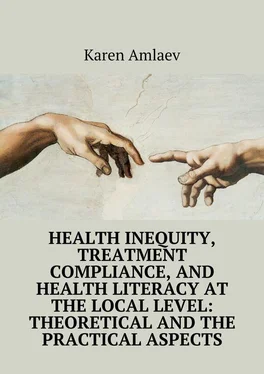?Mechanism 3. Factors related to social inequities (such as health status and biological susceptibility) affect the dependency “impact – response”. Given the same level of impact, disadvantaged groups may reveal a higher level of vulnerability to unfavorable consequences for health, e.g. due to synergy of various risk factors.
?Mechanism 4. Social inequities have a direct impact on the end results related to health, which may reveal itself through both environmental and non-environmental mechanisms. However, under similar dependency parameters of “impact – response” disadvantaged groups may reveal a higher level of vulnerability to unfavorable consequences for health due to poorer access to the respective services and reduced capacity to cope with the negative effects. The absolute scale of the consequences can also be higher in disadvantaged groups because of higher prevalence of previously existing health issues (Whitehead and Dahlgren, 2008).
According to most researches representatives of lower socio-economic groups stand a higher vulnerability to negative environmental factors (Braubach M, Fairburn J., 2010; Bolte G, Tamburlini G, Kohlhuber M., 2010).
Gender features of health inequity and the family role
Research conducted all over the world show that gender is another important factor determining health inequity.
The feature typical of Russia is an extremely high death rate among men and an unprecedented gap between the life expectancy among men and women (12–14 years).
This attracts more attention to men’s health in modern Russia, which overshadows the fact that, according to medical statistics and opinion polls, women have been consistently showing higher rates of health issues.
The lower status of health in Russian women – not only compared to Russian men yet also to women in other countries – is also seen from the calculations of the healthy life expectancy. According to the data provided by the leading Russian demographers the huge gap in the healthy life expectancy of the 20-year olds (both Russian men and women) and their Western counterparts (13 years), in men is due to a higher level of death rate (especially in the working age), and in women – due to a lower health status (mostly in the older age) (Масленникова Г. Я., Оганов Р. Г., 2002, 2004).
Actually, the so-called gender paradox, which could be expressed as “women become ill more often while men die earlier”, which is a global tendency, typical of civilized countries at least, has always been of interest to researchers. For a long time this gender paradox has been explained by medical statistics, supporting the fact that men typically suffer from fatal illnesses and fall prey to illnesses that do not reveal well expressed symptomatology; as for women – they typically suffer from acute and chronic, even though less severe conditions.
Thus, a number of empirical research projects have shown a significant variability in the scale, and sometimes in the patterns of gender-bound health differences at various stages of life cycle, as well as within different health indicators.
According to the theory of unequal impact, women demonstrate a higher level of ill health due to their restricted access to material and public resources that would save health, and because of increased stress accounted for by their gender and family role.
If compared to men women hold different positions: they are more often unemployed, get employment in other areas, and in general they have to enjoy lower income. There are also some gender differences in behavior stereotypes as men are more prone to smoking, alcohol abuse and unbalanced diet, while women are less active physically.
It has also been proven empirically that women carry a heavier burden of responsibility in fulfilling their social roles. Theу also possess a smaller psychological resource required to cope with stresses. In particular, women have a lower awareness of control over life circumstances. At the same time women, if compared to men, have various sources of obtaining some social support.
According to the second approach – vulnerability difference – women demonstrate more health issues as they respond differently (compared to men) to financial, behavioral and socio-psychological circumstances that develop health.
Thus, empirical data shows that full-time employment along with taking care of the family, as well as social support are more important health predictors for women rather than for men.
Tobacco and alcohol consumption are more meaningful health determinants for men while overweight and low physical activity affects women more. While maturing educated girls create smaller and healthier families. The survival rate in their children is higher, and they stand a higher chance of getting education, if compared to children born to less educated mothers (Expert Group Meeting, United Nations, Division for the Advancement of Women (DAW), World Health Organization (WHO), United Nations Population Fund (UNFPA), Tunisia, 1998).
The research conducted in Russia has shown that in women the meaningful determinants of physical functioning include the level of education, awareness of personal responsibility for health, as well as a possibility to spend some time taking care of oneself, while men’s physical condition depends more on a balanced diet and preventive measures. Men’s physical health is especially vulnerable to external impacts at a certain stage of their lives, the pre-retirement decade, to be exact (51–60 years. Gender differences are especially obvious in the health developing mechanisms when analyzing the levels of realized welfare (Назарова И. Б., 2007; Русинова Н. Л., Браун Дж., 1997; Журавлева И. В., 1999, 2006; Русинова Н. Л., Панова Л. В. Сафронов В. В., 2007).
In important issue in healthcare is getting assistance by women in many countries. There is significant evidence showing that women are subject to gender-bound restrictions in terms of getting access to medical assistance, which is true in particular for women from the poorest groups. The obstacles they have to face include lack of culturally adjusted types of assistance, shortage of resources, transportation troubles, suppression, and sometimes even a ban imposed by husband or other family members. Lack of public funding for healthcare affects men as well, yet in view of a limited family budget women’s healthcare needs do not enjoy priority.
Similar issues remain in relation to identification and measuring abuse, family violence, and sexual abuse. The life expectancy of an American woman will depend on ethnic factors: white women live an average of 82,2 years, while for black women this index is 75,5. The infant death rate (per 1,000 births) among the black population is 13,6, among Chinese the infant death rate in America is only 3,5. The maternal mortality among black women over 35 is 71,0 per 100,000 labors, while among white women it is only 11,4. Hite women have a higher rate of breast cancer; however the survival rate within 5 years following treatment in black women is 15 % lower because the tumor in them is detected at later stages. Latin American women have a cervical carcinoma rate that is double of the rate among white women, and their death rate from this issue is 40 % higher. American Indians get antenatal assistance in 69 % of cases while American Japanese – in 90 % of cases. The HIV and AIDS prevalence (per 100,000 women) is 2,3 among the white, 11,8 among Latin Americans, and 50,0 – among the black population. The death rate for infants born to white mothers with no special education is twice higher if compared to white mothers with a degree in higher education (Expert Group Meeting, United Nations, Division for the Advancement of Women (DAW), World Health Organization (WHO), United Nations Population Fund (UNFPA), Tunisia, 1998).
Читать дальше












